Intel Core i7-11700K Review: Blasting Off with Rocket Lake
by Dr. Ian Cutress on March 5, 2021 4:30 PM EST- Posted in
- CPUs
- Intel
- 14nm
- Xe-LP
- Rocket Lake
- Cypress Cove
- i7-11700K
Power Consumption: Hot Hot HOT
I won’t rehash the full ongoing issue with how companies report power vs TDP in this review – we’ve covered it a number of times before. But in a quick sentence, Intel uses one published value for sustained performance, and an unpublished ‘recommended’ value for turbo performance, the latter of which is routinely ignored by motherboard manufacturers. Most high-end consumer motherboards ignore the sustained value, often 125 W, and allow the CPU to consume as much as it needs with the real limits being the full power consumption at full turbo, the thermals, or the power delivery limitations.
One of the dimensions of this we don’t often talk about is that the power consumption of a processor is always dependent on the actual instructions running through the core. A core can be ‘100%’ active while sitting around waiting for data from memory or doing simple addition, however a core has multiple ways to run instructions in parallel, with the most complex instructions consuming the most power. This was noticeable in the desktop consumer space when Intel introduced vector extensions, AVX, to its processor design. The concurrent introduction of AVX2, and AVX-512, means that running these instructions draws the most power.
AVX-512 comes with its own discussion, because even going into an ‘AVX-512’ mode causes additional issues. Intel’s introduction of AVX-512 on its server processors showcased that in order to remain stable, the core had to reduce the frequency and increase the voltage while also pausing the core to enter the special AVX-512 power mode. This made the advantage of AVX-512 suitable only for strong high-performance server code. But now Intel has enabled AVX-512 across its product line, from notebook to enterprise, allowing these chips to run AI code faster and enabling a new use cases. We’re also a couple of generations on from then, and AVX-512 doesn’t get quite the same hit as it did, but it still requires a lot of power.
For our power benchmarks, we’ve taken several tests that represent a real-world compute workload, a strong AVX2 workload, and a strong AVX-512 workload. Note that Intel lists the Core i7-11700K as a 125 W processor.
Motherboard 1: Microcode 0x2C
Our first test using Agisoft Photoscan 1.3 shows a peak power consumption around 180 W, although depending on the part of the test, we have sustained periods at 155 W and 130 W. Peak temperatures flutter with 70ºC, but it spends most of the time at around the 60ºC mark.
For the AVX2 workload, we enable POV-Ray. This is the workload on which we saw the previous generation 10-core processors exceed 260 W.
At idle, the CPU is consuming under 20 W while touching 30ºC. When the workload kicks in after 200 seconds or so, the power consumption rises very quickly to the 200-225 W band. This motherboard implements the ‘infinite turbo’ strategy, and so we get a sustained 200-225 W for over 10 minutes. Through this time, our CPU peaks at 81ºC, which is fairly reasonable for some of the best air cooling on the market. During this test, a sustained 4.6 GHz was on all cores.
Our AVX-512 workload is 3DPM. This is a custom in-house test, accelerated to AVX2 and AVX512 by an ex-Intel HPC guru several years ago (for disclosure, AMD has a copy of the code, but hasn’t suggested any changes).
This tests for 10-15 seconds and then idles for 10 seconds, and does rapidly go through any system that doesn’t run an infinite turbo. What we see here in this power only graph is the alarming peaks of 290-292 W. Looking at our data, the all-core turbo under AVX-512 is 4.6 GHz, sometimes dipping to 4.5 GHz. Ouch. But that’s not all.
Our temperature graph looks quite drastic. Within a second of running AVX-512 code, we are in the high 90ºC, or in some cases, 100ºC. Our temperatures peak at 104ºC, and here’s where we get into a discussion about thermal hotspots.
There are a number of ways to report CPU temperature. We can either take the instantaneous value of a singular spot of the silicon while it’s currently going through a high-current density event, like compute, or we can consider the CPU as a whole with all of its thermal sensors. While the overall CPU might accept operating temperatures of 105ºC, individual elements of the core might actually reach 125ºC instantaneously. So what is the correct value, and what is safe?
The cooler we’re using on this test is arguably the best air cooling on the market – a 1.8 kilogram full copper ThermalRight Ultra Extreme, paired with a 170 CFM high static pressure fan from Silverstone. This cooler has been used for Intel’s 10-core and 18-core high-end desktop variants over the years, even the ones with AVX-512, and not skipped a beat. Because we’re seeing 104ºC here, are we failing in some way?
Another issue we’re coming across with new processor technology is the ability to effectively cool a processor. I’m not talking about cooling the processor as a whole, but more for those hot spots of intense current density. We are going to get to a point where can’t remove the thermal energy fast enough, or with this design, we might be there already.
Smaller Packaging
I will point out an interesting fact down this line of thinking though, which might go un-noticed by the rest of the press – Intel has reduced the total vertical height of the new Rocket Lake processors.
The z-height, or total vertical height, of the previous Comet Lake generation was 4.48-4.54 mm. This number was taken from a range of 7 CPUs I had to hand. However, this Rocket Lake processor is over 0.1 mm thinner, at 4.36 mm. The smaller height of the package plus heatspreader could be a small indicator to the required thermal performance, especially if the airgap (filled with solder) between the die and the heatspreader is smaller. If it aids cooling and doesn’t disturb how coolers fit, then great, however at some point in the future we might have to consider different, better, or more efficient ways to remove these thermal hotspots.
Motherboard 2: Microcode 0x34
As an addendum to this review a week after our original numbers, we obtained a second motherboard that offered a newer microcode version from Intel.
On this motherboard, the AVX-512 response was different enough to warrant mentioning. Rather than enable a 4.6 GHz all-core turbo for AVX-512, it initially ramped up that high, peaking at 276 W, before reducing down to 4.4 GHz all-core, down to 225 W. This is quite a substantial change in behaviour:
This means that at 4.4 GHz, we are running 200 MHz slower (which gives a 3% performance decrease), but we are saving 60-70 W. This is indicative of how far away from the peak efficiency point that these processors are.
There was hope that this will adjust the temperature curve a little. Unfortunately we still see peaks at 103ºC when AVX-512 is first initiated, however during the 4.4 GHz time scale we are more akin to 90ºC, which is far more palatable.
On AVX2 workloads with the new 0x34 microcode, the results were very similar to the 0x2C microcode. The workload ran at 4.6 GHz all-core, reached a peak power of 214 W, and the processor temperature was sustained around 82ºC.
Peak Power Comparison
For completeness, here is our peak power consumption graph. These are the peak power consumption numbers taken from a series of benchmarks on which we run our power monitoring tools.
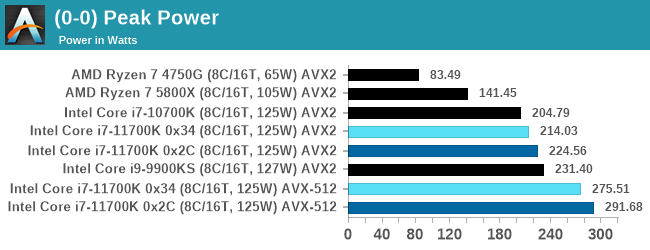



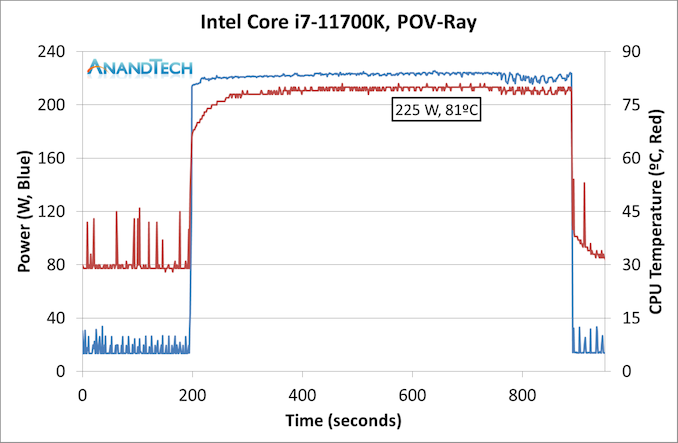
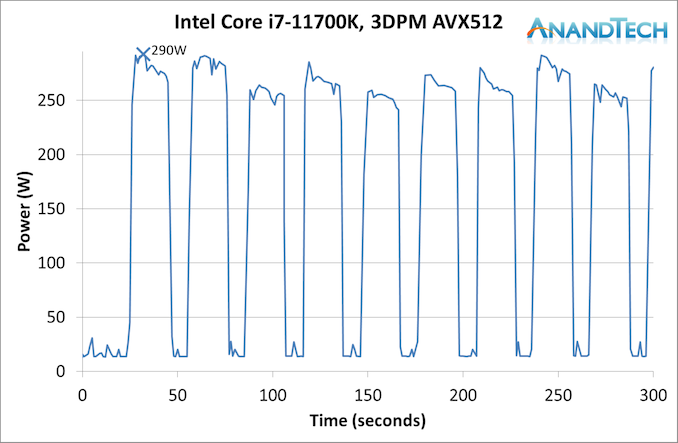
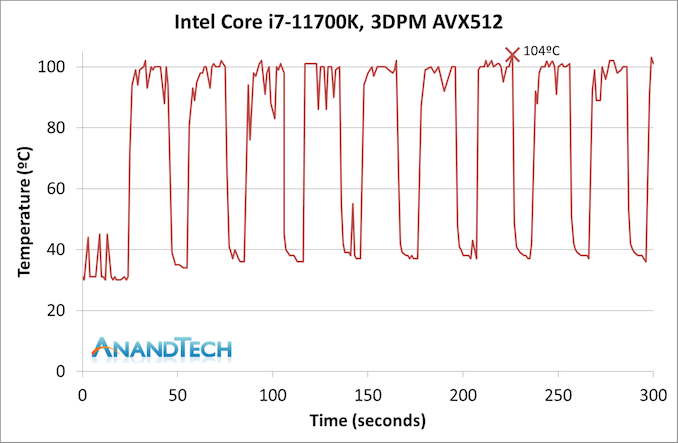


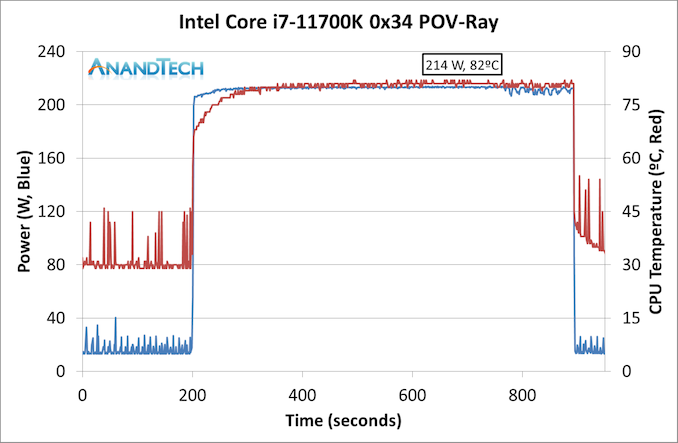








541 Comments
View All Comments
CiccioB - Friday, March 5, 2021 - link
I would like to know what you will say if Anantech will do the same with AMD Ryzen 4, that is reviewing it on an early motherboard with a beta BIOS and not yet tuned microcode and it will result not being as fast as you would expect (or hoped it to be) one month head of the actual release date.And present it as an official review of the product.
I would bet you (and your "friends") would go and cry out for a payed article by Intel to make AMD product look worse that it really is "like the good old times when it payed everywhere on Earth to not make AMD sell its products".
supdawgwtfd - Friday, March 5, 2021 - link
Except it appears the CPU is operating at advertised performance levels...It provides +19% improved performance for some things but not others.
the_eraser1 - Friday, March 5, 2021 - link
It would actually be fine because Zen 4 is already showing 30% performance uplift clock-for-clock, and that's a full year ahead of launch.Be honest with yourself. Achieving even a 5% uplift with microcode optimizations ahead of launch is a pipe dream. The review successfully shows the kind of performance you would expect. Is there room for improvement over time? Of course, but that applies to any product.
CiccioB - Friday, March 5, 2021 - link
I'm not speaking about the improvements in IPC. IPC is not everything to evaluate a product. If that were true ARM chip would be the winner since early '90s.I'm speaking about the fact that in many tests shwn here this architecture shows worse results than the previous one. That would mean there's something really broken in the architecture or in the SW they execute.
About Zen 4, don't old your breath because 5nm for HP are not that close. Even Intel Ocean Cove is said to be the really new revolutionary architecture that is finally going to show what the new 7nm PP could have really brought if it was available today as we speak.
These are speculations, while this chip will be out in less than a month and waiting for the final tuning would have just made a better service to anyone that really wants to know how really it behaves. Not how it looks like on a unknown motherboard with a not updated BIOS and not the final (or even the first version) of the microcode.
the_eraser1 - Friday, March 5, 2021 - link
This performance from RKL is unsurprising if you had been paying attention. We've known for months that Intel hasn't had great results with RKL and that's why they're pushing for Alder Lake ASAP.Once again, you cannot honestly expect substantial performance uplifts a month before launch. It's possible the ring/uncore frequency was low for this review, however that will only make a significant difference in games, or other latency sensitive scenarios.
As for Zen 4, I know for fact from reputable sources that it's coming around the middle of 2022, with large uplifts in performance.
Qasar - Saturday, March 6, 2021 - link
" I'm speaking about the fact that in many tests shwn here this architecture shows worse results than the previous one. That would mean there's something really broken in the architecture or in the SW they execute. " no your crying cause intel still lost. and that well. rocket lake, isnt the performer it was made out to be. AND it looks like some of the performance regressions, were explained/accounted for, in the review, which you obviously did not readOtritus - Saturday, March 6, 2021 - link
Originally ocean cove was leaked to be a revolutionary architecture with a massive ipc uplift that can serve as the backbone for future architectures like Conroe did in the original Core2 line. Leaks have later said that Intel cancelled the revolutionary nature of the product and ocean cove is simply going to be another microarchitecture like sunny or golden cove. By that point AMD should have zen 5 and we the consumer can enjoy healthy competition.As to the point on how it really behaves. We can see from the frequency graphs that rocket lake is turbo boosting as it should. A new BIOS could change power limits which would change behavior, but when rocket lake is already given infinite turbo time, such changes are likely to lead to performance regressions. The only other possibility is that the slight maturation of the bios leads to a small performance uplift. This WOULD BE IPC, but such improvement would be small at best given that z590 (and the similar sunny cove) has been out for a while. At best gaming performance may not suck as hard (or be fixed), but overall the performance improvements should be less than 5%. Not enough to change any conclusion.
My only gripe is the usage of "review" over something that indicates it's a pre-release product. However, given that Intel themselves didn't have any comments on the article, the final performance is likely to be so similar that this is basically the review of the final-release product.
Spunjji - Saturday, March 6, 2021 - link
They've already done that with a bunch of AMD products - like the OEM-only 4000 series APU and the weird Xbox One S APU desktop board.Speaking as a tech enthusiast, if they get hold of Zen 4 before release and can do a preview that doesn't break NDA, I would be over the moon. I love to get an idea of how a release will shape up, as long as there are caveats that it may not be final performance - which is exactly what we got here.
Timoo - Monday, March 8, 2021 - link
I'd Lóve it!Beta BIOS might be a slight disadvantage, but we've seen it with the release of ZEN1. At the time everyone blamed the BIOS for memory compatibility, etc. etc. etc.
In the end, not much improvement was found, once stable BIOSes were out. Bugs were fixed, but ZEN1 was still not beating Intel.
TheinsanegamerN - Monday, March 8, 2021 - link
It would still match the expected out of box performance. Stop being so salty over Intel sucking the big one, RKL is a total dud performance wise, a microcode tweak is not going to increase IPC. It already boosts to where it should be and draws LMFAO power.